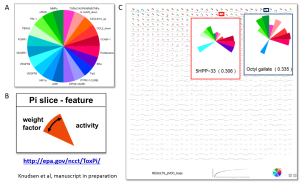Hindsight is always 20/20, especially in the field of science. Given what we know now, it seems crazy that people used to think the world was flat. The realm of toxicology is filled with similar stories (see “pregnancy-boosting” DES and super-insecticide DDT). In the mid-twentieth century America, realization of the harmful effects of chemicals like DES and DDT contributed to rising concern about potential risks to human and environmental health associated with chemicals. Consequently, in efforts to better monitor and understand what chemicals may be harmful to humans and the environment, Congress enacted the Toxic Substance Control Act in 1976, enabling the US Environmental Protection Agency (EPA) to inventory and regulate chemicals being sold or manufactured in the US. As of 2014, 84,000 chemicals are in use in the United States (EPA TSCA).
However, even 39 years later, we know very little about the potentially harmful effects on human health and the environment of a majority of these chemicals (EPA). Traditional toxicology research involves animal studies that are expensive, take years to conduct, and typically use animals, raising questions about how relevant these results are to humans (after all, lab rats are not people). Since the EPA’s inventory grows by 500-1000 chemicals each year, clearly, toxicology researchers are unable to keep up.
Problem: there are too many chemicals and not enough time to test all of them. What to do?
Government agencies are working together to generate more efficient methods of testing all these chemicals. One project is the EPA’s Toxicity Forecaster (ToxCast). Launched in 2007, ToxCast has developed 700 plate-based tests that detect 300 cell signaling pathways and use a variety of approaches, such as exposing human cells or cell receptors to chemicals. By utilizing high-throughput plates (each plate contains 1,536 wells!) and robotic arms that never tire of pipetting, ToxCast is able to screen thousands of chemicals at a time. Thus far, over 2,000 chemicals have been screened, including industrial products, food additives, and “green” chemicals (EPA ToxCast).
To help interpret the massive volume of data generated by ToxCast, scientists developed a software program designed specifically for these analyses. The Toxicity Priority Index (ToxPI) uses ToxCast data to generate a visual representation of a chemical’s biological effects and identifies chemicals that should be prioritized for further investigation.
For example, the process of new blood vessel formation, angiogenesis, is important for tumor growth and survival. The process of angiogenesis involves activation of numerous characteristic cellular pathways. By observing which chemicals activate the pathways involved in angiogenesis using the ToxCast database, researchers can prioritize chemicals that activate more angiogenesis pathways (e.g., have longer slices or more colorful charts indicating many hits in one pathway or interaction with many different pathways, respectively), thus increasing the likelihood that this chemical promotes tumor development and cancer.

Applications of ToxCast and ToxPI are numerous, though their use in research is only in its infancy. ToxCast data is useful for predicting how harmful a chemical might be to the body, either in specific organs or in the body as a whole. These data are especially useful for studying developmental toxicity, as models for testing in utero exposures are limited for ethical and financial reasons. Tests developed for ToxCast have applications in pharmaceutical development, facilitating drug toxicity testing or screening for new potential drugs. ToxCast data can also help discover potential environmental chemicals that contribute to disease. In 2012, researchers at Harvard used the ToxCast database to identify 40 substances that could contribute to very early onset inflammatory bowel disease in children.
Applications of ToxCast and ToxPI will only increase as more researchers partner with EPA and utilize these tools to probe the effects of chemicals on human health. More chemicals are being screened and new plate-based tests are continuously being developed to expand the ToxCast database. While elimination of animal studies is unlikely as significant differences exist between these ToxCast plate-based tests and animals, these screening techniques and ToxPI can help researchers prioritize which chemicals to test. ToxCast’s database will be a powerful tool for helping us obtain toxicity information about the 84,000 (and counting) chemicals in the EPA inventory. Additionally, these tools will enable researchers to answer questions about the effects of chemicals on human health that would have taken years to answer before.
Peer edited by Chris Givens & Tamara Vital
Follow us on social media and never miss a Not So Frivolous Funding article: